Sri Lanka Sightseeing
Sri Lanka Sightseeing
Anuradhapura
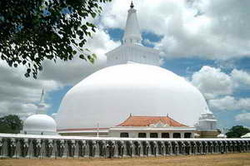
Sri Lanka’s first capital is truly ancient, having ruled the island for more than 1,000 years beginning in 380 BC. The majestic remains are a major highlight of Sri Lanka, with beautiful stupas, temples, and palaces that demonstrate just how advanced the early Sinhalese were. Visitors can sit under the Bo tree where the Buddha gained enlightenment and wander the vast Jetavanarama Dagoba building which once housed more than 1,000 monks. Within this complex are a dozen equally amazing sites. Visitors can easily spend a day or more exploring the area.
Colombo
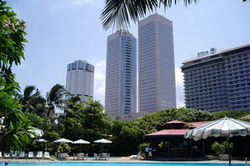
Sri Lanka’s capital is the largest city in the nation. It’s frenetic, noisy and chaotic at times, but there are plenty of things to see and do. Pettah Bazaar is an amazing flurry of local life, while Vihara Maha Devi Park is a quiet oasis of calm. Arguably the best restaurants in Sri Lanka are here, as well as the National Museum, National Art Gallery and lots of great temples and mosques. To experience the unique blend of Dutch, Portuguese, British and Sinhalese influences on Sri Lanka, take your time exploring the streets of Colombo.
Kandy

This picturesque town nestled in the country’s lush, verdant highlands is considered the cultural and spiritual capital of Sri Lanka. As the last stronghold of the mighty Kandyan kings, there is plenty of history here and many ancient customs, arts, crafts and daily rituals are still actively practiced here. While the town itself is the main attraction, don’t miss the UNESCO protected Temple of the Tooth, where one of Buddha’s teeth is enshrined. A wealth of accommodation makes Kandy an ideal place to base yourself for a few days. Visit this website for further information about Kandy tour.
Polonnaruwa
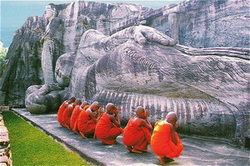
Another of Sri Lanka’s lovely ancient cities can be seen at the lakeside ruins of Polonnaruwa. This site is much more compact than neighbouring Anuradhapura, making it easier to explore if you are short on time. The remains of temples and palaces from the 11th century Indian Chola dynasty are in excellent condition and well worth a visit. Polonnaruwa is located 46 miles southeast of Anuradhapura.
Ridi Vihara

The Silver Temple, as it’s known, has been around since 200 BC and is one of Sri Lanka’s more interesting Buddhist temples. One unique feature is the use of Dutch tiles in the central cave, while the frescoes that adorn the walls are among the finest in the country. The main cave with its gold-plated Buddha and other relics is the main highlight, but you should also check out the Upper Temple, which has its own special character.
Sigiriya

This UNESCO World Heritage site is perhaps Sri Lanka’s most famous attraction, and should not be missed. Perched at the very edge of a towering rock formation is this truly magnificent palace and fortress dating from the 5th century. Water gardens lie at the base of the palace, where steps lead upwards past dozens of beautiful murals to the lofty site of the fort. From the fort, the views are simply astounding.
Dambulla
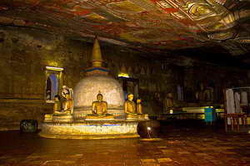
Dambulla is a part of the Cultural Triangle declared by UNESCO is on the main road from Sigiriya to Kandy about 19Km from Sigiriya. There are over 80 caves in the surrounding and some of them have been used by the monks as meditation locations. Major attractions are spread over 5 caves, which contain the statues and the paintings. Since it's founding in the 1 century BC by King Valagamba, many improvements and additions have been carried out to the sculptures and paintings over the years. Hindu statues are believed to be of the 12 century AD and the latest paintings are of the late 18-century. The temple is a perfect location to view evolution of the ancient Sri Lankan arts. Dambulla is a unique and important historical site because of the amalgamation of the material from many eras
Pinnawala
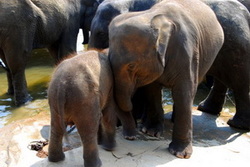
See baby jumbos wondering around their cramped foster home or bottle fed and bathed by their human foster fathers at Pinnawala, about 90Km from Colombo towards Kandy is the home to some 60 or more elephant orphans. A place you will really enjoy and never forget. Most orphans are accustomed to their curious human visitors are harmless.
Started in 1972 the Elephant Orphanage was relocated to at the present site in 1975 Bathing time at Ma Oya just in front of the orphanage is sharp at 10.00am and 2.00pm. Feeding time is about and hour earlier.
Started in 1972 the Elephant Orphanage was relocated to at the present site in 1975 Bathing time at Ma Oya just in front of the orphanage is sharp at 10.00am and 2.00pm. Feeding time is about and hour earlier.
Nuwara Eliya

Situated at around 2000m above sea level and surrounded by lush tea plantations Nuwara Eliya is the main hill resort of Sri Lanka and the heart of the tea industry. Once a pleasure retreat of the European planters the town is still very much an English town with many English style bungalows and buildings. Nuwara Eliya is a good escape for those who miss cool breeze in tropical Sri Lanka at any time of the year. Local tourists flock to this town in their 'season' from March to May when it is the hottest duration for the town, April being the busiest. Nuwara Eliya offers many activities for tourists including visits to tea plantations golfing, horse riding, boating, hiking and of course exploring the beauty of the landscaped gardens, waterfalls and plateaus.
Kitulgala

The film location of "The Bridge over the River Kwai". Remember the film "The Bridge over the River Kwai", it is here the bridge for the film set was built. The beautiful tributary of the Kelani River, over which the bridge was built is still attracting fans to the town. Other attractions include Keleni Forest Reserve a bird watching location, white water rafting and trekking.
This quite town probably had not changed since the days of the filming on 1950s. Kithulgala is about 100Km from Colombo on the main route to Nuwara Eliya via Hatton. The Rest House managed by the Hotel Coporation has been in existence since the filming days and for those want to spend a couple of nights there are new guest houses built recently for the growing number of visitors houses to the town.
This quite town probably had not changed since the days of the filming on 1950s. Kithulgala is about 100Km from Colombo on the main route to Nuwara Eliya via Hatton. The Rest House managed by the Hotel Coporation has been in existence since the filming days and for those want to spend a couple of nights there are new guest houses built recently for the growing number of visitors houses to the town.
Adam's peak
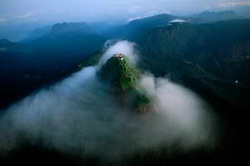
Hill climb of a different type to witness a spectacular sun rise or just for the thrill of the panoramic views of Sri Lanka or for pleasure . Not just a trail but a prilgimage to a summit secred to all of the world's major releigions. The most popular hill trail in Sri Lanka to 2200m above sea level. The season is between December and April when the summit is not misty and relatively dry. There are two popular starting points from the directions of Hatton or Ratnapura.
Easily recognisable from many areas of the western / southern parts of the country because of it's triangle shape summit as well as from the sea to the west. Secret to Christians Muslims as well as Hindus while to Buddhist it is one of the places where Buddha has visited and left a footprint. Today it has been covered by a boulder. The first climbs dates back to 1000AD by then king Vijayabahu I who had built resting places for travellers. Travellers like Ibn Batuta a Arab pilgrim (1304-1377), and Marco Polo (1254-1324) have recorded visiting the summit.
There are few routes to Sri Pada the most used routes are from Ratnapura side or from Hatton/Maskeliya. Public bus services are available from both towns as well as from Colombo and other major towns during the season. From Ratnapura Side. The difficult path start from about 30km from via Kuruwita, Gilimale, Ratnapura. The climb is about 4-6 hours.
Busses are From Hatton, Special Bus service to Sri Pada is available from various destinations. Alternatively visitors by bus from Colombo (or else where) may first go to Maskeliya and then to Delhousie where vehicular approaches end. The trail is around 8 kM. And the climb would take 2-3 hours minimum depending on how fit you are. The forest around the area is a wild life sanctuary famous for its butterflies but also and contains a wealth of flora and fauna.
Easily recognisable from many areas of the western / southern parts of the country because of it's triangle shape summit as well as from the sea to the west. Secret to Christians Muslims as well as Hindus while to Buddhist it is one of the places where Buddha has visited and left a footprint. Today it has been covered by a boulder. The first climbs dates back to 1000AD by then king Vijayabahu I who had built resting places for travellers. Travellers like Ibn Batuta a Arab pilgrim (1304-1377), and Marco Polo (1254-1324) have recorded visiting the summit.
There are few routes to Sri Pada the most used routes are from Ratnapura side or from Hatton/Maskeliya. Public bus services are available from both towns as well as from Colombo and other major towns during the season. From Ratnapura Side. The difficult path start from about 30km from via Kuruwita, Gilimale, Ratnapura. The climb is about 4-6 hours.
Busses are From Hatton, Special Bus service to Sri Pada is available from various destinations. Alternatively visitors by bus from Colombo (or else where) may first go to Maskeliya and then to Delhousie where vehicular approaches end. The trail is around 8 kM. And the climb would take 2-3 hours minimum depending on how fit you are. The forest around the area is a wild life sanctuary famous for its butterflies but also and contains a wealth of flora and fauna.
Bandarawela
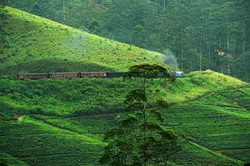
Bandarawela might not be as rich in tea leaves as its Hill Country pals, but it was still the second most important hill station under the Brits who singled out its cool yet dry climate as the perfect place to convalesce. Today, it’s her lush hilly hinterland that draws the cooing crowds. Perched at an altitude of over 1,200m, Bandarawela’s fresh climate is literally made for lumbering outdoors. Discover its delights by hiking up Poonagala Hill to stake out tea estates, paddy fields and wooded jungle glens. Remnants of the British colonialists are fewer in Bandarawela than in neighbouring Nuwara Eliya but the town still manages to evoke a certain nostalgia of its own. The Bandarawela Hotel – a fusty yet atmospheric abode on the edge of town – is its colonial chieftain, since it began life as a cushy clubhouse back in 1893. If you fancy a peek, time it with High Tea so you can snatch a sneaky snoop inside as you sip Ceylon’s finest on the lawn. The Cargill’s building and Post Office opposite the hotel also ooze character since they too date back over 100 years.
Yala national park
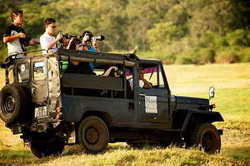
Ruhuna National Park at Yala is Sri Lanka's most popular wild life safari destination. Situated about 300kM from Colombo the 1250 sq kM park is home to leopards, crocodile, elephant, deer, sambar, bear, wild bore, wild buffalo and peacock and may varieties of birds including migratory birds such as flamingos. The uniqueness of the park is it's many different habitat diversities such as dense jungles, lagoons and open park areas, a beautiful sea front and rocky outcrops. Months of January and May are peak month for best of the vegetation and the dry season is from June to October. Hiring of four wheel drive jeep a must for those who want to wonder in to its many trails to explore the national park.
There are many archaeological sites within the park and the ancient monastery of Sithulpahuwa situated at a beautiful rocky platform is among it's most visited sites.
Salt pans at Palatupana is a popular location for bird watching.
The leopards is the largest member of the wild cats found in Sri Lanka and Yala is probably the best location to view these beast in their natural habitat.
There are many archaeological sites within the park and the ancient monastery of Sithulpahuwa situated at a beautiful rocky platform is among it's most visited sites.
Salt pans at Palatupana is a popular location for bird watching.
The leopards is the largest member of the wild cats found in Sri Lanka and Yala is probably the best location to view these beast in their natural habitat.
Bentota

Bentota used to be a place to rest on the way to Galapatha Temple which legend claims is linked by a maze of subterranean tunnels with all other temples in the area. Today Bentota is big on sea sports and activities; so you may well need a holiday after you get back! On Bentota lagoons calm waters you can enjoy everything from jet skiing and windsurfing to wakeboarding and canoeing. Boat trips up the river and deep sea fishing trips depend on weather conditions. Many independent diving schools operate along the beach front during diving season, between December and March/April.
But if thats too much like work, take a brief respite to see the results of a labour of love at the very private Brief, a Jardin tranquille near Kalawila. Sculpted over forty years, it was anything but a brief diversion for Capability Bawa- brother of the renowned architect Geoffrey Bawa who designed some of the most enchanting buildings in Asia, including Lunuganga with an equally magical garden. Brief has a Japanese garden, a Folly, several walled gardens and hidden surprises as well as a private museum of Art inside the house and out.
But if thats too much like work, take a brief respite to see the results of a labour of love at the very private Brief, a Jardin tranquille near Kalawila. Sculpted over forty years, it was anything but a brief diversion for Capability Bawa- brother of the renowned architect Geoffrey Bawa who designed some of the most enchanting buildings in Asia, including Lunuganga with an equally magical garden. Brief has a Japanese garden, a Folly, several walled gardens and hidden surprises as well as a private museum of Art inside the house and out.
Galle
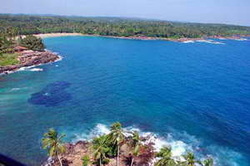
Old Galle is a UNESCO World Heritage Site. The Galle Fort itself is still a living monument with a bustling community within the great ramparts, massive bastions, pepper pot towers, while narrow streets display its Dutch heritage with beckoning pillared verandas and fretwork facades. Walking around is best so you can peep through frangipani filled courtyards at houses, galleries or shops selling antiques, spices, pictures, nouveau-boule and hand-woven sarongs. Boutique hotels in Galle incongruously cheek by jowl with postage-stamp size cafes, so you are never far from a perfect sun-downer. Pondicherri meets Cadaques! But step outside the Citadel, and a different city with a different agenda is the ‘New Galle’ tussling with bustle, noise and chaotic traffic coming in every direction. Keep a hanky close for exhaust fumes or a whiff of Old Delhi can get very much in yer face! Especially at the Dutch Market where fruit and vegetable sellers hawk their wares or the Fish Market where today’s catch is chilling. After the mayhem of the day be sure that wherever there is the greatest view, a veritable gem of architecture secretly sits, glamorous and illusive as an old movie star, meticulously restored from 300-year old merchant’s villa, with cobbled courtyards now transformed into glistening sea-water pools.
The early traders got blown into Serendib’s ancient port by the Trade Winds which acted as shuttle service for Roman, Greek, Arab and Chinese who came and saw and conquered prizes of ‘gold, silver, ivory, apes and peacocks’. Today’s traveller can use those very same winds to kite-surf. Or deep sea fish, dive, trek to rainforests, see Buddhist temples, explore eco-villages which makes time stand still, promenade on stone ramparts 20 meters thick and let history and legend seep into his bones in “one of the world’s last authentic island destinations”.
The early traders got blown into Serendib’s ancient port by the Trade Winds which acted as shuttle service for Roman, Greek, Arab and Chinese who came and saw and conquered prizes of ‘gold, silver, ivory, apes and peacocks’. Today’s traveller can use those very same winds to kite-surf. Or deep sea fish, dive, trek to rainforests, see Buddhist temples, explore eco-villages which makes time stand still, promenade on stone ramparts 20 meters thick and let history and legend seep into his bones in “one of the world’s last authentic island destinations”.
Galle / Unawatuna / Hikkaduwa
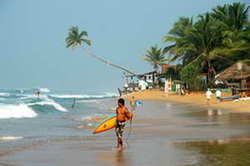
West of Galle before you hit the bustle and high jink of Hikkaduwa, are perfect, clean, un-peopled beaches between Narigama and Dodanduwa. Right in front of the Fort is Sea Bath. Jungle Beach, the most ruggedly natural, magical place, cannot be easily approached from land due to thick – you guessed it- jungle! But any friendly fisherman will deliver you there for a Robinson Crusoe experience. Unawatuna, the first bay after passing town is still one of the prettiest and great for diving, snorkelling, wave surfing, deep-sea fishing with a Goa-esque flavour; beach cafes and a disco along the strip with a Hindu kovil perching right on the point. Surf-friendly tuk-tuk drivers are invariably surf-bums who can take you with long-boards to surf-idyllic spots such as Midigama and offer valuable coaching to boot. Very useful in Sri Lanka where Life Guards don’t exist and big waves do.
Wijaya beach, 10 kms from Galle with a restaurant tumbling onto the sand is like going down to the pub on a Sunday because all the Brits gather here. A natural lagoon forms a safe paddling pool close to the sun-dozing Mums and there’s a natural Jacuzzi’s amongst the rocks; no locals, so relaxed atmosphere for shy single girls. Talpe is a whole kilometre of wide, undisturbed white sand with a reef, so parts are safe for swimming and others suitable for surf (in season) You can walk till the end of the rainbow and footprints on the sand are quite likely your own.
Wijaya beach, 10 kms from Galle with a restaurant tumbling onto the sand is like going down to the pub on a Sunday because all the Brits gather here. A natural lagoon forms a safe paddling pool close to the sun-dozing Mums and there’s a natural Jacuzzi’s amongst the rocks; no locals, so relaxed atmosphere for shy single girls. Talpe is a whole kilometre of wide, undisturbed white sand with a reef, so parts are safe for swimming and others suitable for surf (in season) You can walk till the end of the rainbow and footprints on the sand are quite likely your own.
Tangalle
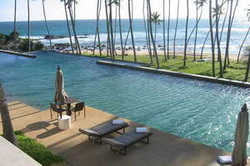
At Dondra Head, the southern most tip of the island an octagonal lighthouse brings home that there is nothing between you and Antarctica! The indigo sea is a swirl of coral, rock and foam. At Maha Vishnu devale – a 7th century shrine once pillaged by the Portuguese of its gilded Copper roof, a week long Dondra Festival and a full scale Pera Hera venerates God Vishnu with fire-walking and devil-dancing at midnight. Talalla Beach is a mile of picture-postcard crescent around a cove of glassy calm when most beaches have strong winds. An Oz-run restaurant yards from the beach does excellent fusion sea food. After Dickwella where brackish lagoons yield harvests of delicious prawns, the beaches don’t even have names but picking-your-own here means having a whole piece of heaven to yourself! Nilwala Cove this side of Tangalle is enchanting with a reef which provides surf further out and safe swimming within. At Kudawilla, the ferociously noisy Hoom-mane Blowhole spurts a spectacular 60 foot high fountain of water for its Cabaret in June. Villages say when the sea is rough it reaches a height of “three coconut trees”. North of Tangalle is Mulkirigala, a black rock temple thrusting 300 feet into the sky with beautifully preserved murals. In 1826, erstwhile government Agent of Ratnapura, George Turnour discovered ola leaf scripts which unlocked 23 centuries of Lanka’s missing history. On your way back try to visit a citronella distillery.
Bundala Bird Sanctuary (also elephants/crocodile/monkeys) is 75 minutes east of Tangalle but as you approach Hambantota in a white fog of un-mechanised salt pans there is much birdlife; finally holy Kataragama, a pilgrim destination where Muslims, Hindu, Buddhist gather in July after walking the length of the island from Jaffna to venerate Lord Skanda by boldly strolling on burning coals.
Bundala Bird Sanctuary (also elephants/crocodile/monkeys) is 75 minutes east of Tangalle but as you approach Hambantota in a white fog of un-mechanised salt pans there is much birdlife; finally holy Kataragama, a pilgrim destination where Muslims, Hindu, Buddhist gather in July after walking the length of the island from Jaffna to venerate Lord Skanda by boldly strolling on burning coals.
Weligama

Driving along from Ahangama, you begin to notice the famous Stilt fishermen perched like curious-looking birds all the way towards Weligama. At one end of the sleepy town, stands a megalith to the memory of Kustaraja- the Leper king- who became miraculously cured of his dreaded disease by consuming copious amounts of King Coconut water. The catamarans are a good way to grab a ride round this picturesque bay, and fishermen are most obliging in between fishing trips. At the prettiest end of the bay, you can wade out at low tide to She-devil Island or Taprobane, which appears like an islet out of a James Bond movie. It was built in the 30’s by Count de Mauny, a French landscape architect who created this legendary folly on a piece of land which was originally a cobra dump. The octaganal white villa has attracted everyone from Noel Coward, Paul Bowles and Robin Maugham and is currently featured in Hip Hotels.
If you head towards Mirissa, a picture-postcard beach for wave surfing and swimming, you won`t need any further entertaining; but if you are trying to keep up with the Indiana Joneses, the Snake Farm (14 kms from Weligama) has 15 different varieties of snake, some of them are extremely large and serious-looking pythons, and Tarantulas which were probably displaced when Count de Mauny sent them packing!
If you head towards Mirissa, a picture-postcard beach for wave surfing and swimming, you won`t need any further entertaining; but if you are trying to keep up with the Indiana Joneses, the Snake Farm (14 kms from Weligama) has 15 different varieties of snake, some of them are extremely large and serious-looking pythons, and Tarantulas which were probably displaced when Count de Mauny sent them packing!
Negombo / Airport
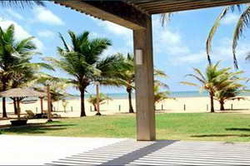
A photographer’s paradise – from gaudy, chaotic festivals erupting on the streets, to the bleached, beached and beautiful Oruva outrigger canoe catamarans. It’s hard to believe these driftwood sculptures have been braving the breakers for centuries but, if you’re up early, you’ll spot them delivering their catch. And this is really what keeps Negombo’s heart beating, the exchange of fish at dawn markets such as Lellama, with its pipe-smoking fisherwomen. Just north of the airport, Negombo is equally cursed and blessed. The proliferation of hotels along the beach strip behind Lewis Place are often only used as an overnight stopping point with complaints that both beach and town are seedier than other parts of this ideal island.
But you don’t have to cast far to reel in delight after sumptuous delight on Sri Lanka’s largely uncharted northwest coast. A cruise inland, through Andalankawa – “moon of Sri Lanka”, takes you through the idyllic rice paddy and coconut plantation landscape chosen by locals as a wedding backdrop. Another handy bit of tackle is a hired bike which allows you to dissolve into the tiny warren of streets along the extensive network of canals. Built by the Dutch to transport spices and gems from the luscious interior, they can lead you back to old-world life and unexpected treasures.
If you were seriously energetic, you could follow the canals 130 kilometers north, past Puttalam, and go kite-surfing to cool off. An old Portuguese port on a long spit of a peninsula, Kalapitiya is fast becoming a destination. Here you can watch dolphins and whales an hour from the coast. Past the prawn farms, the clever kids of Colombo play on perfect, pink sandy beaches, swimming in water, warm as tea, clear as gin. No need to fish here – the compliments come easy.
But you don’t have to cast far to reel in delight after sumptuous delight on Sri Lanka’s largely uncharted northwest coast. A cruise inland, through Andalankawa – “moon of Sri Lanka”, takes you through the idyllic rice paddy and coconut plantation landscape chosen by locals as a wedding backdrop. Another handy bit of tackle is a hired bike which allows you to dissolve into the tiny warren of streets along the extensive network of canals. Built by the Dutch to transport spices and gems from the luscious interior, they can lead you back to old-world life and unexpected treasures.
If you were seriously energetic, you could follow the canals 130 kilometers north, past Puttalam, and go kite-surfing to cool off. An old Portuguese port on a long spit of a peninsula, Kalapitiya is fast becoming a destination. Here you can watch dolphins and whales an hour from the coast. Past the prawn farms, the clever kids of Colombo play on perfect, pink sandy beaches, swimming in water, warm as tea, clear as gin. No need to fish here – the compliments come easy.
Sri Lanka Tour Packages
Sri Lanka 4 Days Tour Itinerary |
Sri Lanka 5 Days Tour Itinerary |
Sri Lanka 6 Days Tour Itinerary |
Sri Lanka 7 Days Tour Itinerary |
Sri Lanka 8-9 Days Tour Itinerary |
Sri Lanka 10-14 Days Tour Itinerary |
Send Inquiry For Sri Lanka Travel
|
ABOUT US
Sanki Leisure is a local destination management company and excels with quality services from its experienced staff. Over the years the company has received positive feedback from its existing clients and hence one can expect a cordial reception.
|
LINKS
|
CONTACT INFO
|
SERVICES
|
©
Copyright 2024 - www.srilankantours.org - Sanki Leisure (private) Ltd. All Rights Reserved. PV-100291





